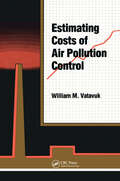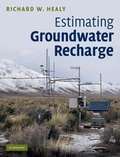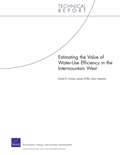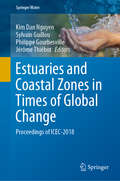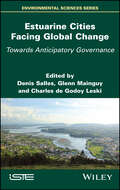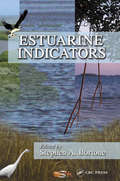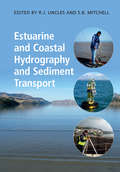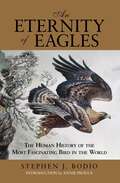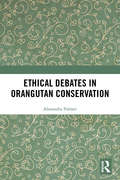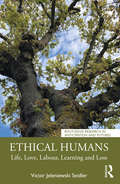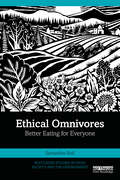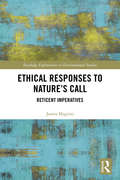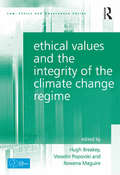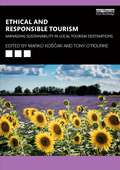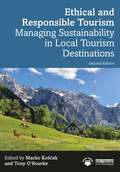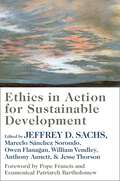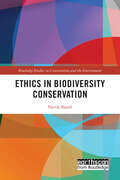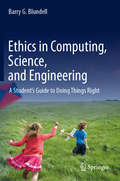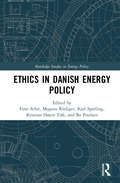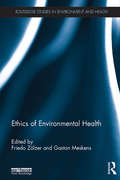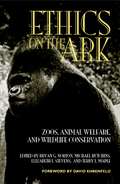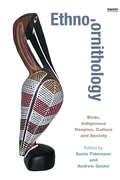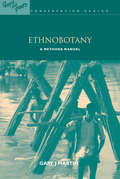- Table View
- List View
Estimating Costs of Air Pollution Control
by William M. VatavukIn these pages is all the information that you-manager, engineer, or other technical professional-would need to select, size, and estimate "budget/study" level capital and annual costs for a variety of air pollution control equipment. This equipment includes wet scrubbers, carbon adsorbers, and other "add-on" devices. This book also deals with such nonstack controls as wet dust suppression systems and flue gas desulfurization systems. The costs are current (1988 or 1989 dollars) and are mainly presented in equational form for ease of computerization and updating. Clear, comprehensive equipment sizing procedures are also detailed. Finally, several detailed example problems are included to illustrate the sizing and costing procedures. This book is not just for technical personnel, however. The material is easy to grasp and use. Anyone with an air pollution control background can follow and apply the procedures and data herein. Using this book, air pollution control professionals can now develop sound, defensible (within ±30%) cost estimates with a minimum of time and effort.
Estimating Groundwater Recharge
by Richard W. Healy Bridget R. ScanlonUnderstanding groundwater recharge is essential for successful management of water resources and modeling fluid and contaminant transport within the subsurface. This book provides a critical evaluation of the theory and assumptions that underlie methods for estimating rates of groundwater recharge. Detailed explanations of the methods are provided - allowing readers to apply many of the techniques themselves without needing to consult additional references. Numerous practical examples highlight benefits and limitations of each method. Approximately 900 references allow advanced practitioners to pursue additional information on any method. For the first time, theoretical and practical considerations for selecting and applying methods for estimating groundwater recharge are covered in a single volume with uniform presentation. Hydrogeologists, water-resource specialists, civil and agricultural engineers, earth and environmental scientists and agronomists will benefit from this informative and practical book, which is also a useful adjunct text for advanced courses in groundwater or hydrogeology.
Estimating the Value of Water-Use Efficiency in the Intermountain West
by James Griffin Sara Hajiamiri David G. GrovesThis report presents an economic framework for estimating a water agency's avoided costs and environmental benefits of increasing water-use efficiency. The report demonstrates this framework by evaluating the benefits of Denver Water's efficiency programs and utilizes an exploratory modeling approach to accommodate significant uncertainty. The analysis highlights the importance of considering both long- and short-run costs and benefits.
Estuaries and Coastal Zones in Times of Global Change: Proceedings of ICEC-2018 (Springer Water)
by Philippe Gourbesville Kim Dan Nguyen Sylvain Guillou Jérôme ThiébotThis book is a collection of extended papers based on presentations given during the ICEC 2018 conference, held in Caen, France, in August 2018. It explores both the limitations and advantages of current models, and highlights the latest developments concerning new numerical schemes, high-performance computing, multi-physics and multi-scale methods, and better interaction with field or scale model data. Accordingly, it addresses the interests of practitioners, stakeholders, researchers, and engineers active in this field.
Estuarine Cities Facing Global Change: Towards Anticipatory Governance
by Denis Salles Glenn Mainguy Charles de Godoy LeskiAt the heart of the globalization of trade and of economies, estuarine cities are at the forefront of accelerating global change. They must confront the tensions generated by their demographic and socio-economic attractions and their ecological vulnerability linked to their location in trade flows, downstream of rivers and at the interface between land and sea. Using the examples of the estuarine cities of the Gironde, the Loire and the Seine and their specific challenges, such as climate change, flood risk, biodiversity, port flows and urban planning, this book analyzes their emerging trajectories guided by proactive governance of global change.
Estuarine Indicators
by Stephen A. BortoneAcknowledging the present inability to determine objectively the status and trends among estuarine ecosystems, the environmental research community has recently stepped up efforts to develop and evaluate meaningful estuarine indicators. This goal requires the effort of researchers from a broad spectrum of disciplines. In order to expedite this init
Estuarine and Coastal Hydrography and Sediment Transport
by Mitchell R. J. Uncles S. B.A practical guide to the latest remote and in situ techniques used to measure sediments, quantify seabed characteristics, and understand physical properties of water and sediments and transport mechanisms in estuaries and coastal waters. Covering a broad range of topics from global reference frames and bathymetric surveying methods to the use of remote sensing for determining surface-water variables, enough background is included to explain how each technology functions. The advantages and disadvantages of each technology are explained, and a review of recent fieldwork experiments demonstrates how modern methods apply in real-life estuarine and coastal campaigns. Clear explanations of physical processes show links between different disciplines, making the book ideal for students and researchers in the environmental sciences, marine biology, chemistry and geology, whose work relies on an understanding of the physical environment and the way it is changing as a result of climate change, engineering and other influences.
Eternity of Eagles: The Human History of the Most Fascinating Bird in the World
by Stephen J. BodioAn Eternity of EaglesThe Human History of the Most Fascinating Bird in the WorldA compulsively readable natural and social history, An Eternity of Eagles is a profusely illustrated celebration of all things eagle, by a naturalist who has kept eagles himself and ridden with the eagle tribes of Central Asia."His vivid description of an eagle, if it could imagine itself, is of a 'carnivorous Buddhist.' Through Bodio&’s insights we get a strange glimpse of these other minds that share the earth with us."--Annie Proulx, author of The Shipping News and Brokeback MountainFrom one of the foremost author/naturalists in the country, Stephen J. Bodio, comes a compulsively readable natural and social history of the most beautiful bird in the world -- the eagle, with a lengthy and admiring introduction by Annie Proulx.The Eagle&’s Shadow traces our love-hate relationship to these &“living dinosaurs,&” from Neolithic rock art and Native American religion through the practices of Kazakh falconers who use them to hunt wolves, and to contemporary art and popular culture.Proulx sums up best the heart of this book: &“Those of us who are interested in bird behavior beyond the feeder or the identification guide book find meager pickings when it comes to information. I am fortunate that my house faces a cliff with a river at the base where I can watch raptors, water fowl, and a hundred other species. The nests of a pair of bald eagles and another upriver inhabited by golden eagles are in sight from the breakfast table. I have plenty of books on birds, but the information on why the big eagles do what they do is hard to dig out. Eagle behavior is usually lumped together with the general behavior of the Accipitrids, but a single book focused on the rich lore and sweep of eagledom did not seem to exist… . Bodio&’s beautifully written and authoritative book, Eagles, is a primary source of information as well as an omnium gatherum from literature, film and mythology concerning these large, striking birds.&”Stephen Bodio was born and educated in Boston and has lived in a rural New Mexico village for over thirty years. He has traveled extensively in Europe, Africa, and Asia and has written five books.
Ethical Adaptation to Climate Change
by Allen Thompson Jeremy Bendik-KeymerPredictions about global climate change have produced both stark scenarios of environmental catastrophe and purportedly pragmatic ideas about adaptation. This book takes a different perspective, exploring the idea that the challenge of adapting to global climate change is fundamentally an ethical one, that it is not simply a matter of adapting our infrastructures and economies to mitigate damage but rather of adapting ourselves to realities of a new global climate. The challenge is to restore our conception of humanity--to understand human flourishing in new ways--in an age in which humanity shapes the basic conditions of the global environment. In the face of what we have unintentionally done to Earth's ecology, who shall we become? The contributors examine ways that new realities will require us to revisit and adjust the practice of ecological restoration; the place of ecology in our conception of justice; the form and substance of traditional virtues and vices; and the organizations, scale, and underlying metaphors of important institutions. Topics discussed include historical fidelity in ecological restoration; the application of capability theory to ecology; the questionable ethics of geoengineering; and the cognitive transformation required if we are to "think like a planet. "
Ethical Debates in Orangutan Conservation
by Alexandra PalmerEthical Debates in Orangutan Conservation explores how conservationists decide whether, and how, to undertake rehabilitation and reintroduction (R&R) when rescuing orphaned orangutans. The author demonstrates that exploring ethical dilemmas is crucial for understanding ongoing disagreements about how to help endangered wildlife in an era of anthropogenic extinction. Although R&R might appear an uncontroversial activity, there is considerable debate about how, and why, it ought to be practised. Drawing on in-depth qualitative research with orangutan conservation practitioners, this book examines how ethical trade-offs shape debates about R&R. For example, what if the orphan fails to learn how to be an orangutan again, after years in the company of humans? What if she is sent into the forest only to slowly starve? Would she have been better off in a cage? Could the huge cost of sending a rescued ape back to the wild be better spent on stopping deforestation in the first place? Or do we have a moral obligation to rescue the orphan regardless of cost? This book demonstrates that deconstructing ethical positions is crucial for understanding ongoing disagreements about how to help our endangered great ape kin and other wildlife. Ethical Debates in Orangutan Conservation is essential reading for those interested in conservation and animal welfare, animal studies, primatology, geography, environmental philosophy, and anthropology.
Ethical Humans: Life, Love, Labour, Learning and Loss (Routledge Research in Anticipation and Futures)
by Victor Jeleniewski SeidlerEthical Humans questions how philosophy and social theory can help us to engage the everyday moral realities of living, working, loving, learning and dying in new capitalism. It introduces sociology as an art of living and as a formative tradition of embodied radical eco post-humanism. Seeking to embody traditions of philosophy and social theory in everyday ethics, this book validates emotions and feelings as sources of knowledge and shows how the denigration of women has gone hand in hand with the denigration of nature. It queries post-structuralist traditions of anti-humanism that, for all their insights into the fragmentation of identities, often sustain a distinction between nature and culture. The author argues that in a crisis of global warming, we have to learn to listen to our bodies as part of nature and draws on Wittgenstein to shape embodied forms of philosophy and social theory that questions theologies that tacitly continue to shape philosophical traditions. In acknowledging our own vulnerabilities, we question the vision of the autonomous and independent rational self that often remains within the terms of dominant white masculinities. This book offers different modes of self-work, drawing on psychoanalysis and embodied post-analytic psychotherapies as part of a decolonising practice questioning Eurocentric colonising modernity. In doing so it challenges, with Simone Weil, Roman notions of power and greatness that have shaped visions of white supremacy and European colonial power and empire. This book will be of great interest to students and scholars of environmental ethics, environmental philosophy, social theory and sociology, ethics and philosophy, cultural studies, future studies, gender studies, post-colonial studies, Marxism, psychoanalysis and psychotherapy and philosophy and sociology as arts of living.
Ethical Omnivores: Better Eating for Everyone (Routledge Studies in Food, Society and the Environment)
by Samantha NollThis book provides a detailed overview of ethical omnivorism, as well as the philosophical foundations of this movement and diet.Many eaters are concerned about the impact that their food choices have on the environment, animals, and human health. Ethical omnivorism is at once a new food ethic, diet, and global movement aimed at providing a flexible path for eaters committed to bringing about lasting change one meal at a time. While publications in food ethics are largely dominated by vegetarian titles, this book explores the viability of omnivorism, a dietary choice which is not devoid of animal products, but one which embraces eating local, eating organic, and eating humanely raised food products. In doing so, this diet builds on the local food movement’s desire to know where food comes from and stresses the importance of maintaining high animal welfare and environmental standards. Overall, this book provides a foundational overview of ethical omnivorism as a food movement and guidance for those interested in eating ethically, while recognizing that many factors influence dietary choices.This book will be of great interest to students and scholars of food studies, food, agriculture and animal ethics, environmental philosophy, and those more widely interested in making ethical food choices.
Ethical Responses to Nature’s Call: Reticent Imperatives (Routledge Explorations in Environmental Studies)
by James MagriniArguing for a renewed view of objects and nature, Ethical Responses to Nature’s Call considers how it is possible to understand our ethical duties - in the form of ethical intuitionalism - to nature and the planet by listening to and releasing ourselves over to the call or address of nature. Blending several strands of philosophical thought, such as Graham Harman’s Object-Oriented Ontology, W. D. Ross’s prima fathics, Alphonso Lingis’s phenomenological ethics traceable to The Imperative, and Michael Bonnett’s ecophilosophy, this book offers a unique rejoinder to the problems and issues that continue to haunt humans’ relationship to nature. The origins of such problems and issues largely remain obscured from view due to the oppressive influence of the "Cultural Framework" which gives form and structure to the ways we understand, discourse on, and comport ourselves in relation to the natural world. Through understanding this "Cultural Framework" we also come to know the responses we continue to offer in answer to nature’s call and address, and are then in a position to analyze and assess those responses in terms of their potential ethical weight. Such a phenomenon is made possible through the descriptive-and-interpretive method of eco-phenomenology. This renewed vision of the human-and-nature provides direction for our interaction with and behavior toward nature in such a way that the ethical insight offers a diagnosis and provides a potentially compelling prescriptive for environmental ills.
Ethical Values and the Integrity of the Climate Change Regime (Law, Ethics and Governance)
by Vesselin Popovski Hugh BreakeyThis book investigates the ethical values that inform the global carbon integrity system, and reflects on alternative norms that could or should do so. The global carbon integrity system comprises the emerging international architecture being built to respond to the climate change. This architecture can be understood as an 'integrity system'- an inter-related set of institutions, governance arrangements, regulations and practices that work to ensure the system performs its role faithfully and effectively. This volume investigates the ways ethical values impact on where and how the integrity system works, where it fails, and how it can be improved. With a wide array of perspectives across many disciplines, including ethicists, philosophers, lawyers, governance experts and political theorists, the chapters seek to explore the positive values driving the global climate change processes, to offer an understanding of the motivations justifying the creation of the regime and the way that social norms impact upon the operation of the integrity system. The collection focuses on the nexus between ideal ethics and real-world implementation through institutions and laws. The book will be of interest to policy makers, climate change experts, carbon taxation regulators, academics, legal practitioners and researchers.
Ethical and Responsible Tourism: Managing Sustainability in Local Tourism Destinations
by Tony O'Rourke Marko Kos AkEthical and Responsible Tourism explains the methods and practices used to manage the environmental impact of tourism on local communities and destinations. The three core themes of the book – destination management, environmental and social aspects of ethical sustainable development and business impacts – are discussed across both topic and case study chapters, alongside explanatory editorial analysis with all chapters clearly signposted and interlinked. The case studies address specific and practical examples from a global range of examples including sites in Australia, Central America, Europe Union countries, Japan, North America and South America. Used as a core textbook, the linking of theory in the topic chapters, and practice gained through case studies, alongside further reading and editorial commentary, Ethical and Responsible Tourism provides a detailed and comprehensive learning experience. Specific case studies can be used as standalone examples as part of a case teaching approach, and the editorial and discussion elements are designed to be suitable for those simply seeking a concise overview, such as tourism professionals or potential investors in sustainable tourism projects. This book will be essential reading for students, researchers and practitioners of tourism, environmental and sustainability studies.
Ethical and Responsible Tourism: Managing Sustainability in Local Tourism Destinations
by Marko KoščakEthical and Responsible Tourism explains the methods and practices used to manage the environmental impact of tourism on local communities and destinations. This new edition takes into account recent global events such as the Covid-19 health crisis, the impacts of the war in Ukraine on tourism in neighbouring regions and the consequences of the energy and cost of living crisis. The three core themes of the book – destination management, environmental and social aspects of ethical sustainable development and business impacts – are discussed across both topic and case study chapters, alongside explanatory editorial analysis with all chapters clearly signposted and interlinked. The case studies address specific and practical examples from a global range of examples including sites in Australasia, Central America, Europe, Asia, North America and South America. In this new edition, further case studies are included from the USA and Japan, as well as new examples from Brazil, Croatia and Malta. Used as a core textbook, the linking of theory in the topic chapters, and practice gained through case studies, alongside further reading and editorial commentary, Ethical and Responsible Tourism provides a detailed and comprehensive learning experience. Specific case studies can be used as standalone examples as part of a case teaching approach, and the editorial and discussion elements are designed to be suitable for those simply seeking a concise overview, such as tourism professionals or potential investors in sustainable tourism projects. This revised edition continues to be essential reading for students, researchers and practitioners of tourism, environmental and sustainability studies.
Ethics and the Environment: An Introduction
by Dale JamiesonThis book is an introduction to the philosophical issues involved in this important question, focussing primarily on ethics but also encompassing questions in aesthetics and political philosophy. Topics discussed include the environment as an ethical question, human morality, meta-ethics, normative ethics, humans and other animals, the value of nature, and nature's future.
Ethics in Action for Sustainable Development
by Sachs, Jeffrey D.; Sorondo, Marcelo Sánchez; Flanagan, Owen; Vendley, William; Annett, Anthony; Thorson, JesseThe Sustainable Development Goals, adopted by the United Nations in 2015, comprise an ambitious and sweeping agenda that unites economic, social, and environmental aims. What resources do the world’s religious and secular traditions offer in support of these objectives? Which principles do these traditions hold in common, and how can these shared values help advance global goals?This book presents an in-depth and deeply engaged conversation among interfaith religious leaders and interdisciplinary scholars and practitioners in pursuit of an ethical consensus that could ground sustainable development efforts. Drawing on more than two years of close-knit discussions convened by Jeffrey D. Sachs and Marcelo Sánchez Sorondo, it offers an extensive and inclusive vision of how to promote human flourishing. The book features theological, philosophical, and ethical deliberations of great diversity and depth on the challenges of sustainable development, addressing questions of poverty, environmental justice, peace, conflict, and the future of work. It includes consensus statements on the moral imperatives of sustainable development, introductions to seven major religious traditions and their conceptions of the common good, and thematic reflections. Wide-ranging and urgent, this book represents a major contribution to interreligious dialogue and to the articulation of a shared global ethics.The book features a foreword by Pope Francis and Ecumenical Patriarch Bartholomew.
Ethics in Biodiversity Conservation (Routledge Studies in Conservation and the Environment)
by Patrik BaardThis book examines the role of ethics and philosophy in biodiversity conservation. The objective of this book is two-fold: on the one hand it offers a detailed and systematic account of central normative concepts often used, but rarely explicated nor justified, within conservation biology. Such concepts include ‘values’ (both intrinsic, instrumental, and, more recently, relational), ‘rights’, and ‘duties’. The second objective is to emphasize to environmental philosophers and applied ethicists the many interesting decision-making challenges of biodiversity conservation. The book argues that a nuanced account of instrumental values provides a powerful tool for reasoning about the values of biodiversity. It also scrutinizes relational values, the concept of rights of nature, and risk, and show how moral philosophy proves indispensable for these concepts. Consequently, it engages with recent suggestions on normative aspects of biodiversity conservation, and show the need for moral philosophy in biodiversity conservation. The overriding aim of this book is to provide conservation biologists and policy-makers with a systematic overview of concepts and assessments of the reasons for reaching prescriptive conclusions about biodiversity conservation. This will prove instrumental in clarifying the role of applied ethics and a refined understanding of the tools it can provide. This title will be of interest to students and scholars of conservation biology, conservation policy, environmental ethics and environmental philosophy.
Ethics in Computing, Science, and Engineering: A Student’s Guide to Doing Things Right
by Barry G. BlundellThis comprehensive textbook introduces students to the wide-ranging responsibilities of computing, science and engineering professionals by laying strong transdisciplinary foundations and by highlighting ethical issues that may arise during their careers. The work is well illustrated, and makes extensive use of both activities, and ethical dilemmas which are designed to stimulate reader engagement. A number of memorable case studies are also included and frequently draw on the demanding aerospace industry. The book adopts a strongly human centric approach, with matters such as privacy erosion and censorship being viewed not only in their current context but also in terms of their ongoing evolution. What are our individual ethical responsibilities for ensuring that we do not develop for future generations a technological leviathan with the potential to create a dystopian world? A broad range of technologies and techniques are introduced and are examined within an ethical framework. These include biometrics, surveillance systems (including facial recognition), radio frequency identification devices, drone technologies, the Internet of Things, and robotic systems. The application and potential societal ramifications of such systems are examined in some detail and this is intended to support the reader in gaining a clear insight into our current direction of travel. Importantly, the author asks whether we can afford to allow ongoing developments to be primarily driven by market forces, or whether a more cautious approach is needed. Further chapters examine the benefits that are associated with ethical leadership, environmental issues relating to the technology product lifecycle (from inception to e-waste), ethical considerations in research (including medical experimentation involving both humans and animals), and the need to develop educational programs which will better prepare students for the needs of a much more fluid employment landscape. The final chapter introduces a structured approach to ethical issue resolution, providing a valuable, long-term source of reference. In addition it emphasises the ethical responsibilities of the professional, and considers issues that can arise when we endeavour to effect ethically sound change within organisations. Examples are provided which highlight the possible ramifications of exercising ethical valour. The author has thus created an extensively referenced textbook that catalyses student interest, is internationally relevant, and which is multicultural in both its scope and outlook.
Ethics in Danish Energy Policy (Routledge Studies in Energy Policy)
by Bo Poulsen Finn Arler Mogens Rüdiger Karl Sperling Kristian Høyer ToftThis book deepens our understanding of ethical drivers in energy policy and contributes to future decision-making on transitions towards a sustainable energy system. During the latest fifty years Western energy politics have been faced with a series of ethical challenges including rapid growth, oil crises, security of supply, nuclear power and climate change. Combining philosophical, historical and planning approaches into one narrative, these dilemmas are explored using Denmark as the key case study. Drawing on contributions from several experts in the field, the ethics of energy is investigated from multiple perspectives at the individual, corporate, local and national levels, focusing on concrete decisions where different ethical considerations are weighted against each other. This comprehensive approach helps to gain a deeper understanding of the energy sector’s history and gives important input to its future layout. Drawing comparisons with European and global examples, this book will be of great interest to students and scholars of energy politics and policy, environmental ethics, climate change and sustainability transitions.
Ethics of Environmental Health (Routledge Studies in Environment and Health)
by Friedo Zölzer Gaston MeskensEnvironmental health encompasses the assessment and control of those environmental factors that can potentially affect human health, such as radiation, toxic chemicals and other hazardous agents. It is often assumed that the assessment part is just a matter of scientific research, and the control part a matter of implementing standards which unambiguously follow from that research. But it is less commonly understood that environmental health also requires addressing questions of an ethical nature. How can we determine the "acceptable" risk level for the general population or for certain groups? How should we deal with uneven distributions of risks and benefits? How do we communicate about risks with the stakeholders? This multidisciplinary collection brings together a number of leading researchers and scholars in order to generate discussion surrounding these key questions, and to bring the ethical implications of science and technology to the forefront of critical thought. Providing a broad overview of the Ethics of Environmental Health, its philosophical foundations and practical applications, this book offers a significant contribution to ongoing discussions in sustainable development and will be of interest to scholars and practitioners of Environmental Health, urban studies and healthcare.
Ethics on the Ark: Zoos, Animal Welfare, and Wildlife Conservation
by Terry Maple Elizabeth Stevens Michael Hutchins Bryan G. NortonEthics on the Ark presents a passionate, multivocal discussion--among zoo professionals, activists, conservation biologists, and philosophers--about the future of zoos and aquariums, the treatment of animals in captivity, and the question of whether the individual, the species, or the ecosystem is the most important focus in conservation efforts. Contributors represent all sides of the issues. Moving from the fundamental to the practical, from biodiversity to population regulation, from animal research to captive breeding, Ethics on the Ark represents an important gathering of the many fervent and contentious viewpoints shaping the wildlife conservation debate.From the Trade Paperback edition.
Ethno-ornithology: Birds, Indigenous Peoples, Culture and Society
by Andrew Gosler Sonia TidemannIndigenous knowledge that embraces ornithology takes in whole social dimensions that are inter-linked with environmental ethos, conservation and management for sustainability. In contrast, western approaches have tended to reduce knowledge to elemental and material references. This book looks at the significance of indigenous knowledge of birds and their cultural significance, and how these can assist in framing research methods of western scientists working in related areas. As well as its knowledge base, this book provides practical advice for professionals in conservation and anthropology by demonstrating the relationship between mutual respect, local participation and the building of partnerships for the resolution of joint problems. It identifies techniques that can be transferred to different regions, environments and collections, as well as practices suitable for investigation, adaptation and improvement of knowledge exchange and collection in ornithology. The authors take anthropologists and biologists who have been trained in, and largely continue to practise from, a western reductionist approach, along another path - one that presents ornithological knowledge from alternative perspectives, which can enrich the more common approaches to ecological and other studies as well as plans of management for conservation.
Ethnobotany: A Methods Manual (People and Plants International Conservation)
by Gary J. MartinEthnobotany, the study of the classification, use and management of plants by people, draws on a range of disciplines, including natural and social sciences, to show how conservation of plants and of local knowledge about them can be achieved. Ethnobotany is critical to the growing importance of developing new crops and products such as drugs from traditional plants. This book is the basic introduction to the field, showing how botany, anthropology, ecology, economics and linguistics are all employed in the techniques and methods involved. It explains data collection and hypothesis testing and provides practical ideas on fieldwork ethics and the application of results to conservation and community development. Case studies illustrate the explanations, demonstrating the importance of collaboration in achieving results. Published with WWF, UNESCO and Royal Botanic Gardens Kew.
